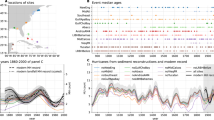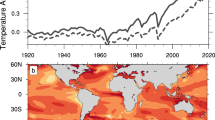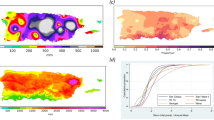Abstract
Arising from: Nyberg et al. Nature 447, 698–701 (2007)10.1038/nature05895; Nyberg et al. reply
The anomaly of the recent increase in Atlantic major hurricane activity (MHA) is controversial. From a reconstruction of past MHA, Nyberg et al.1 conclude that the present activity is not unusual by comparison with that of the past 270 years. However, here I estimate the uncertainty of average MHA in the hurricane record2 before 1945 and show that the reconstruction of Nyberg et al.1 differs strongly from that record, and probably overestimates past MHA. Owing to this and further reasons, I question whether their reconstruction provides an accurate basis for conclusions about past MHA.
Similar content being viewed by others
Main
Nyberg et al.1 reconstruct MHA for the past 270 years using data sets from coral and sediment cores as well as sea surface temperature (SST) data. Their reconstruction shows a huge difference compared to the hurricane record2 before 1944. The authors explain this by the unreliability of that record. However, uncertainties in the record, owing to possible underreporting of tropical storms, are not unlimited. Relative to 1966–2002, the highest estimates of under-reporting are about two tropical storms per year from 1900 to 1965, and two to three tropical storms in the 19th century3,4.
To estimate the possible underreporting of MHA, I used the ratio of the number of major hurricanes to the total number of tropical storms, assuming a constant ratio over the long term. I adjusted the number of tropical storms for the estimations given in refs 3 and 4, which for 1851–1885 is a range from zero to six tropical storms for a single year (three per year on average), for 1885–1900 is a range from zero to four (two on average), and for 1900–1965 is two tropical storms (Fig. 1, black line). The average major hurricane/tropical storm ratio for 1966–2006 and the average corrected ratio for 1910–1965 are both 0.21. Therefore, no MHA correction is indicated for 1910–1965. To adjust the considerably lower ratio for 1851–1910, a correction of plus one major hurricane per year on average is needed (Fig. 1, red line). Figure 1 (blue line) shows that the ratio is strongly correlated to the number of major hurricanes. This is also true for 1851–1910 after the correction, and shows that the correction seems reasonable and should provide an upper limit of past MHA. This upper limit yields almost exactly two major hurricanes per year on average between 1851 and 1940. The Nyberg et al.1 reconstruction, which produces clearly more than three (about 3.3) major hurricanes on average over that period, overestimates major hurricane frequency before 1940 by at least ∼60%. Even an extreme adjustment of plus five tropical storms before 1900 and a MHA correction according to the plus-two-tropical-storm-adjustment from 1900–1944 would still show an overestimation of about 35%.
The black line shows the five-year moving average of the ratio between major hurricanes and the total number of tropical storms2 after correction of the observational bias of tropical storm number proposed by refs 3 and 4. The red line and the blue line show the ratio and the number of major hurricanes, respectively, after correction for a possible observational bias of major hurricanes before 1910.
Another important problem of the reconstruction is that the two basic data sets show an inverse long-term trend regarding their relationship to MHA, at least for 1730–1950. According to the coral data, there would have been a positive MHA trend over the reconstruction period, but, according to the sediment data, there would have been a negative trend. Thus, at least one of the two data sets must produce a wrong long-term trend of MHA.
Moreover, one of the data sets shows an inverse spatial correlation to wind shear north and south of about 22° N latitude, respectively1 (that is, when wind shear is relatively high in the south, it is low in the north). Since 1944, about 50% of major hurricanes have reached major hurricane strength only north of 22° N where mainly an inverse wind shear anomaly is observed. Thus, the influences of the inverse wind shear anomalies north and south of 22° N on MHA might cancel each other out, at least to some degree.
The reconstruction probably overestimates the influence of wind shear and underestimates the influence of SSTs, because over the calibration period there is a clear multi-year trend of wind shear but only a small trend of SSTs. Therefore, the relationship to SSTs might not be well calibrated. A calibration over the periods before or after the calibration period adopted in the paper (1946–1990), where multi-year SST trends are more pronounced than wind shear trends, would probably produce a considerably different reconstruction, especially regarding the long term. The dominant influence of SSTs in the recent activity increase, for example, has been shown in other studies5,6.
These problems seriously undermine the reliability of the reconstruction, especially before 1940, and therefore the main conclusions of Nyberg et al.1
References
Nyberg, J. et al. Low Atlantic hurricane activity in the 1970s and 1980s compared to the past 270 years. Nature 447, 698–701 (2007)
Best track data of the NOAA National Hurricane Center (HURDAT). 〈http://www.aoml.noaa.gov/hrd/hurdat/Data_Storm.html〉 (data used as published 11 June 2007). (Hurricane Research Division, US National Oceanic and Atmospheric Administration.)
Landsea, C. W. Counting Atlantic tropical cyclones back to 1900. Eos 18, 197–208 (2007)
Landsea, C. W. et al. in Hurricanes and Typhoons: Past, Present and Future (eds Murname, R. J. & Liu, K.-B.) 177–221 (Columbia Univ. Press, New York, 2004)
Hoyos, C. D., Agudelo, P. A., Webster, P. J. & Curry, J. A. Deconvolution of the factors contributing to the increase in global hurricane intensity. Science 312, 94–97 (2006)
Mann, M. E. & Emanuel, K. A. Atlantic hurricane trends linked to climate change. Eos 87, 233–241 (2006)
Author information
Authors and Affiliations
Rights and permissions
About this article
Cite this article
Neu, U. Is recent major hurricane activity normal?. Nature 451, E5 (2008). https://doi.org/10.1038/nature06576
Received:
Accepted:
Issue Date:
DOI: https://doi.org/10.1038/nature06576
This article is cited by
-
Atlantic hurricanes and climate over the past 1,500 years
Nature (2009)
-
Nyberg et al. reply
Nature (2008)
Comments
By submitting a comment you agree to abide by our Terms and Community Guidelines. If you find something abusive or that does not comply with our terms or guidelines please flag it as inappropriate.




